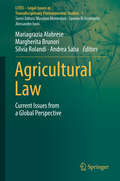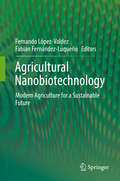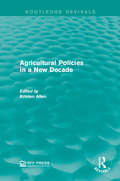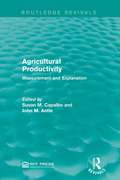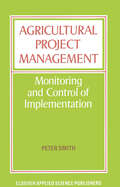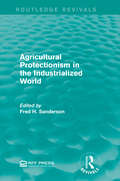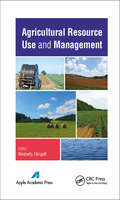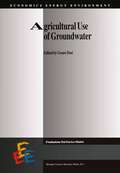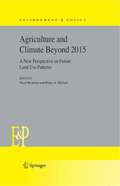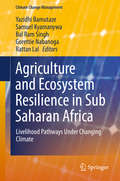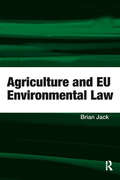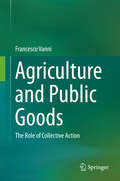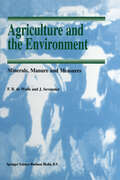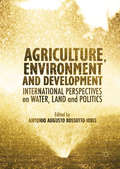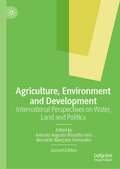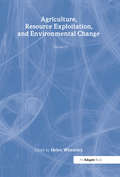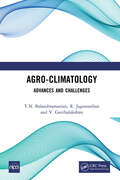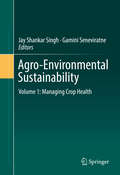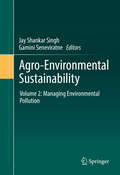- Table View
- List View
Agricultural Law: Current Issues from a Global Perspective (LITES - Legal Issues in Transdisciplinary Environmental Studies #1)
by Mariagrazia Alabrese Margherita Brunori Silvia Rolandi Andrea SabaThis book focuses on the social and environmental issues being addressed by agricultural law within the current globalised system.What is agricultural law? Agricultural regulations concern and affect essential human needs and values that must be dealt with by pursuing a comprehensive and coordinated global approach. By tracking the developments in this context, this book explores the new challenges that agricultural law needs to address in order to frame emerging dilemmas.International governance of natural resources and their role in addressing food insecurity is the object of the first Part of the volume, which deals with sustainable agriculture and agro-ecosystem services in connection with the food security issue.The second Part focuses on the regulation of food as the main product of agricultural activity, and explores the answers that the law can provide in order to accommodate consumers’ interests and concerns (inter alia, novel foods, animal welfare, direct sales and e-commerce). The third Part examines the social, environmental and legal consequences of a renewed interest in agricultural investments. Further, it analyses the evolution and the interplay between different legal systems with regard to land tenure, environmental concerns and investments in agriculture.
Agricultural Nanobiotechnology
by Fernando López-Valdez Fabián Fernández-LuqueñoNanobiotechnology in agriculture is a new knowledge area that offers novel possibilities to achieve high productivity levels at manageable costs during the production and merchandising of crops. This book shows us how we can use the cutting-edge knowledge about agriculture, nanotechnology, and biotechnology to increase the agricultural productivity and shape a sustainable future in order to increase the social welfare in rural areas and preserve the environmental health. Specialists from several countries will provide their feedback on a range of relevant topics such as environment-friendly use of nanofertilisers, nanodevices, nano-food packaging, nanocoating and nanocarriers and their relationship with the modern agriculture.
Agricultural Policies in a New Decade (Routledge Revivals)
by Kristen AllenAgricultural Policies in a New Decade was written in preparation for the 1990 Farm Bill in the United States in collaboration with the Food and Agriculture Committee of the National Planning Association. Originally published in the same year, this study aims to inform on the key issues affecting the new bill including budget austerity, the effects of agriculture on environmental quality, the safety and security of the U.S. food supply and international markets and trade policy. This title will be of interest to students of Environmental Studies and policy makers.
Agricultural Policies in a New Decade (Routledge Revivals)
by Kristen AllenAgricultural Policies in a New Decade was written in preparation for the 1990 Farm Bill in the United States in collaboration with the Food and Agriculture Committee of the National Planning Association. Originally published in the same year, this study aims to inform on the key issues affecting the new bill including budget austerity, the effects of agriculture on environmental quality, the safety and security of the U.S. food supply and international markets and trade policy. This title will be of interest to students of Environmental Studies and policy makers.
Agricultural Productivity: Measurement and Explanation (Routledge Revivals)
by Susan M. Capalbo John M. AntleThis book, first published in 1988, provides a comprehensive, integrated body of knowledge concerning agricultural productivity research, highlighting both its strengths and limitations. This book will be of value to scholars and research leaders for the knowledge it conveys of future productivity research, and will also be of interest to students of environmental studies.
Agricultural Productivity: Measurement and Explanation (Routledge Revivals)
by Susan M. Capalbo John M. AntleThis book, first published in 1988, provides a comprehensive, integrated body of knowledge concerning agricultural productivity research, highlighting both its strengths and limitations. This book will be of value to scholars and research leaders for the knowledge it conveys of future productivity research, and will also be of interest to students of environmental studies.
Agricultural Project Management: Monitoring and Control of Implementation
by Peter SmithI first became interested in the methods of planning the sequence and timing of jobs on large-scale development projects, as a field officer involved in planning and implementing mechanised farming schemes in Uganda in the mid-sixties. This interest was reinforced by experience of agro-industrial projects in both Nigeria and Iran, when it became obvious that the lax traditional methods of both planning and controll ing the implementation of agricultural and other rural development projects were very ineffective compared with those already in use in other disciplines. An extended spell as Resident Adviser on a World Bank project to strengthen planning and project management services in the agricultural sector in Sind Province, Pakistan, stimulated this interest further, and gave opportunities to develop the use of improved methods on some very complex schemes. This book summarises the experience gained in adapting critical path methods, well established in other fields, to Third World development projects, with their peculiar problems. It would not have been possible to reach this point without the help and stimulation of discussions with a large number of colleagues, includ ing John Joyce (then of Hunting Technical Services), Hatsuya Azumi (World Bank), and-particularly-Zaffar Sohrwardy and Akhtar Ali of Aarkays Associates in Karachi, during our work together. My thanks are also due to Yasin Mohammed, who typed most of the original draft; Anwar Mohammed and Irene Mills for final typing; and to my wife, Jill, for drawing the original figures.
Agricultural Protectionism in the Industrialized World (Routledge Revivals)
by Fred H. SandersonOriginally published in 1990, Agricultural Protectionism in the Industrialized World takes a detailed look into the domestic and international agricultural policies of the United States, Europe, Canada, Japan, Australia and New Zealand. These areas are some of the most industrialised in the world and this study focuses on the benefits, policies and costs related to protectionism of their agriculture. These papers offer detailed analysis of the evolution, objections and domestic and international implications related to agriculture in specific countries as well as taking a global view of issues such as policy, trends and costs and concluding with a discussion on the effects of free trade. This title will be of interest to students of environmental studies.
Agricultural Protectionism in the Industrialized World (Routledge Revivals)
by Fred H. SandersonOriginally published in 1990, Agricultural Protectionism in the Industrialized World takes a detailed look into the domestic and international agricultural policies of the United States, Europe, Canada, Japan, Australia and New Zealand. These areas are some of the most industrialised in the world and this study focuses on the benefits, policies and costs related to protectionism of their agriculture. These papers offer detailed analysis of the evolution, objections and domestic and international implications related to agriculture in specific countries as well as taking a global view of issues such as policy, trends and costs and concluding with a discussion on the effects of free trade. This title will be of interest to students of environmental studies.
Agricultural Resource Use and Management
by Kimberly EtingoffThis title includes a number of Open Access chapters.Agriculture is one of the prime users of water, particularly in arid places with already-limited water resources, and its effects are diverse and far reaching. Providing a nuanced study of agricultural resource management, this informative book takes a four-pronged approach, covering research on:
Agricultural Use of Groundwater: Towards Integration Between Agricultural Policy and Water Resources Management (Economics, Energy and Environment #17)
by Cesare DosiGroundwater is endangered and polluted in several ways. Conservation and better management of this invisible resource should be a key ingredient of sustainable water policies. This is especially true in areas, such as many Mediterranean regions, which are already exposed to scarcity problems and which are likely to experience increasing competition between freshwater uses and users. Agriculture is an important user of groundwater not only in terms of abstractions, but also in terms of generation and release of pollutants. Agricultural policies, traditionally directed towards other objectives, are beginning to pay more attention to environmental considerations. However more effective initiatives are required to reduce the pressure upon groundwater resources and to achieve a better integration between agricultural and environmental policies. This book has been developed from three workshops held as part of the EU Concerted Action SAGA, "Sustainable Agricultural Use of Aquifers in Southern Europe: Integration between Agricultural and Water Management Policies" (FAIR5-CT97-3673). The Concerted Action and the workshops brought together researchers working in different but complementary fields, in order to get a picture of the state-of-the art about interlinkages between agriculture and groundwater, as well a critical review of alternative regulatory approaches and policy instruments aimed at improving groundwater management.
Agriculture and Climate Beyond 2015: A New Perspective on Future Land Use Patterns (Environment & Policy #46)
by Floor Brouwer Bruce A. McCarlInteractions between agriculture, climate and patterns of land use are complex. Major changes in agriculture, and land use patterns are foreseen in the next couple of decades in response to shifts in climate, greenhouse gas management initiatives, population growth and other forces. The book explores key interactions between changes in agriculture, patterns of land use and efforts to reduce greenhouse emissions from agriculture. The volume is based on inter-disciplinary science and policy interactions, exploring the way land use may aid in addressing or be affected by the onset of climate change and alterations in food demand. Future forces shaping land use decisions are examined, and its sensitivity to climate change is highlighted. Patterns of land use and the agricultural role in climate change mitigation are explored. Also, policy and social responses to the new perspectives on future land use patterns are identified. The perspective of the book is beyond the year 2015.
Agriculture and Ecosystem Resilience in Sub Saharan Africa: Livelihood Pathways Under Changing Climate (Climate Change Management)
by Rattan Lal Bal Ram Singh Yazidhi Bamutaze Samuel Kyamanywa Gorettie NabanogaThis volume discusses emerging contexts of agricultural and ecosystem resilience in Sub Saharan Africa, as well as contemporary technological advances that have influenced African livelihoods. In six sections, the book addresses the sustainable development goals to mitigate the negative impacts on agricultural productivity brought about by climate change in Africa. Some of the challenges assessed include soil degradation, land use changes, natural resource mismanagement, declining crop productivity, and economic stagnation. This book will be of interest to researchers, NGOs, and development organizations.Section 1 focuses on climate risk management in tropical Africa. Section 2 addresses the water-ecosystem-agriculture nexus, and identifies the best strategies for sustainable water use. Section 3 introduces Information Communication Technology (ICT), and how it can be used for ecosystem and human resilience to improve quality of life in communities. Section 4 discusses the science and policies of transformative agriculture, including challenges facing crop production and management. Section 5 addresses landscape processes, human security, and governance of agro-ecosystems. Section 6 concludes the book with chapters uniquely covering the gender dynamics of agricultural, ecosystem, and livelihood resilience.
Agriculture and EU Environmental Law
by Brian JackThis book critically examines the development and current structure of European Union agri-environmental measures at a substantive level. Examining the measures in an integrated manner, showing how they interrelate linking different aspects of European Union agricultural law and policy, this volume examines the legislation adopted at European Union level as well as the impact of particular national measures to implement that legislation. Where appropriate, comparisons are drawn between the manner in which European Union legislation has been implemented among various Member States. Critically assessing European Union and national measures, in the light of other policy pressures such as the influence of world trade agreements and the political pressures exerted by the agricultural sector within the national legal systems of individual Member States, this volume is a valuable resource for academics researching and practitioners working in the areas of European Union environmental and agricultural law.
Agriculture and EU Environmental Law
by Brian JackThis book critically examines the development and current structure of European Union agri-environmental measures at a substantive level. Examining the measures in an integrated manner, showing how they interrelate linking different aspects of European Union agricultural law and policy, this volume examines the legislation adopted at European Union level as well as the impact of particular national measures to implement that legislation. Where appropriate, comparisons are drawn between the manner in which European Union legislation has been implemented among various Member States. Critically assessing European Union and national measures, in the light of other policy pressures such as the influence of world trade agreements and the political pressures exerted by the agricultural sector within the national legal systems of individual Member States, this volume is a valuable resource for academics researching and practitioners working in the areas of European Union environmental and agricultural law.
Agriculture and Public Goods: The Role of Collective Action
by Francesco VanniThe debate on the future orientation of the EU Common Agricultural Policy (CAP) is increasingly shaped by the role of agriculture in providing public goods, and there is a broad consensus that this approach will be particularly relevant in legitimating the policy intervention in agriculture in the future.In the context of this debate, it is not clear to what extent collective action could be taken into consideration as a valuable alternative to market or state regulation in contributing to the provision of public goods, and to what extent it is possible to design and implement agricultural policies that incorporate a collective and collaborative approach between different stakeholders in rural areas.Through an in depth analysis two case studies in Italy, the book provides insights to both the policy and the theoretical debate on the role of collective action for the public goods associated to agriculture.
Agriculture and the Environment: Minerals, Manure and Measures (Soil & Environment #7)
by F.B. de Walle J. SevensterIn this study, an overview is presented of agricultural policies on manure and minerals, relating to the Nitrate Directive to remedy excessive surface- and groundwater contamination from intensive agricultural practices. Six countries belonging to the European Union were studied: the Netherlands, Belgium, Denmark, France, Germany and the United Kingdom. The policies and their legal incorporation were related to agricultural and environmental conditions in each country. In addition, an inventory was made of agricultural mineral poli cies in the United States and Canada. Conditions for livestock farming in North America differ considerably from those in Europe, but their solutions shed a different light on European policies. Research has shown that there are still very considerable mineral surpluses in many countries and regions. In both the Netherlands and in the Flemish part of Belgium, existing problems due to very high levels of manure production are structural rather than local and cannot easily be solved by transport of manure to other regions. To a lesser extent. Germany, Denmark and relatively small parts of France (Brittany) and the United Kingdom, still exceed the norms for an equilibrium fertilization. In Denmark, existing problems can probably be solved within the existing legislative framework. The Netherlands, Flanders. several German Lander (Nordrhein-Westfalen and Schleswig-Holstein) and Brittany.
Agriculture, Environment and Development: International Perspectives on Water, Land and Politics
by Antonio A.R IorisThis book deals with past legacies and emerging challenges associated with agriculture production, water and environmental management, and local and national development. It offers a critical interpretation of the tensions associated with the failures of mainstream regulatory regimes and the impacts of global agri-food chains. The various chapters include conceptual and empirical material from research carried out in Brazil, India and Europe. The assessment takes into account the dilemmas faced by farmers, companies, policy-makers and the international community related to growing food demand, water scarcity and environmental degradation. The book also questions most government reactions to those problems that tend to reproduce old, productivist approaches and are normally under the powerful influence of global corporations, mega-supermarkets and investment funds. Its overall message is that the trajectory of agriculture, rural development and environmental management are integral elements of the broader search for justice and novel socio-ecological thinking.
Agriculture, Environment and Development: International Perspectives on Water, Land and Politics
by Antonio Augusto Rossotto Ioris Bernardo Mançano FernandesThe Second Edition of this book is completely revised and updated throughout providing an overview of current challenges faced within the area of Agri-food in relation to policymaking, ecological conservation and socio-environmental justice. Including a range of new chapters, the book explores some of the conceptual and analytical gaps that are presented by current approaches to this topic. The series of interconnected chapters offers a critical reinterpretation of the tensions associated with the failures of mainstream regulatory regimes, land and resource grabbing, and the impacts of global agri-food chains at local, regional and inter-sectoral scales. The book also examines past legacies and emerging challenges associated with agriculture modernisation, politico-spatial disputes, climate change, social movements, gender, ethnicity and education. It likewise addresses the transformative potential of different combinations of biophysical, socio-technical and socio-spatial practices of food sovereignty.
Agriculture, Resource Exploitation, and Environmental Change (An Expanding World: The European Impact on World History, 1450 to 1800)
by Helen WheatleyThis volume examines the ecological consequences of European expansion as a result of land use and resource exploitation. These environmental transformations could be as dramatic as the last Ice Age, but scholars have only begun to take full measure of the changes. The articles presented here provide a map of some of the more promising directions of historical research. Major themes include biological exchange, agriculture, extraction of forest and animal resources, interactions between indigenous and European methods of exploitation, and European approaches to regulation and conservation. A useful corrective to the frontier image of Europeans conquering the wilderness, this volume provides a rich picture of the diversity of European interests and the sometimes unexpected consequences of their approaches to the land.
Agriculture, Resource Exploitation, and Environmental Change (An Expanding World: The European Impact on World History, 1450 to 1800 #17)
by Helen WheatleyThis volume examines the ecological consequences of European expansion as a result of land use and resource exploitation. These environmental transformations could be as dramatic as the last Ice Age, but scholars have only begun to take full measure of the changes. The articles presented here provide a map of some of the more promising directions of historical research. Major themes include biological exchange, agriculture, extraction of forest and animal resources, interactions between indigenous and European methods of exploitation, and European approaches to regulation and conservation. A useful corrective to the frontier image of Europeans conquering the wilderness, this volume provides a rich picture of the diversity of European interests and the sometimes unexpected consequences of their approaches to the land.
Agro-Climatology: Advances and Challenges
by T.N. Balasubramanian R. Jagannathan V. GeethalakshmiThe chapters in this book cover crop -weather interaction and agro-met observatory, agro-climatic analysis, crop micro-meteorology, remote sensing, crop simulation models, weather codes and their management, integrated weather forecast and agro advisories, climate change, livestock climatology/meteorology and astrometeorology. To understand the text of the book, under terminology, simple details have been given for hard technical words. Further and above all, under practical tools, important computations and calculations have been given with example, which is the unique of this publication. The authors feel that this publication would be very useful to under graduates, postgraduates, research scholars, publics, teachers and also to the politicians to take policy decisions on the subject. Note: T&F does not sell or distribute the hardback in India, Pakistan, Nepal, Bhutan, Bangladesh and Sri Lanka. This title is co-published with NIPA.
Agro-Climatology: Advances and Challenges
by T.N. Balasubramanian R. Jagannathan V. GeethalakshmiThe chapters in this book cover crop -weather interaction and agro-met observatory, agro-climatic analysis, crop micro-meteorology, remote sensing, crop simulation models, weather codes and their management, integrated weather forecast and agro advisories, climate change, livestock climatology/meteorology and astrometeorology. To understand the text of the book, under terminology, simple details have been given for hard technical words. Further and above all, under practical tools, important computations and calculations have been given with example, which is the unique of this publication. The authors feel that this publication would be very useful to under graduates, postgraduates, research scholars, publics, teachers and also to the politicians to take policy decisions on the subject. Note: T&F does not sell or distribute the hardback in India, Pakistan, Nepal, Bhutan, Bangladesh and Sri Lanka. This title is co-published with NIPA.
Agro-Environmental Sustainability: Volume 1: Managing Crop Health
by Jay Shankar Singh Gamini SeneviratneThis two-volume work is a testament to the increasing interest in the role of microbes in sustainable agriculture and food security. Advances in microbial technologies are explored in chapters dealing with topics such as carbon sequestration, soil fertility management, sustainable crop production, and microbial signaling networks. Volume I is a collection of research findings that invites readers to examine the application of microbes in reinstating degraded ecosystems and also in establishing sustainable croplands. Highly readable entries attempt to close the knowledge gap between soil microbial associations and sustainable agriculture. An increase in the global population with changing climate is leading to environments of various abiotic and biotic stresses for agricultural crops. It therefore becomes important to identify the techniques to improve soil fertility and function using different microbial groups such as actinobacteria, microalgae, fluorescent pseudomonads and cyanobacterial systems. These are examined in this volume in greater detail. This work is a significant contribution to research in this increasingly important discipline, and will appeal to researchers in microbiology, agriculture, environmental sciences, and soil and crop sciences.
Agro-Environmental Sustainability: Volume 2: Managing Environmental Pollution
by Jay Shankar Singh Gamini SeneviratneThis two-volume work is a testament to the increasing interest in the role of microbes in sustainable agriculture and food security. Advances in microbial technologies are explored in chapters dealing with topics such as plant-microbe interactions, rhizoremediation and cyanoremediation, and bio-immobilization. Volume II is a collection of research findings that invites readers to examine the application of microbes in pollution reduction, decontamination of agro- and aquatic ecosystems, and remediation of various toxic compounds. Highly readable entries attempt to close the knowledge gap between soil microbial associations and sustainable agriculture. Traditional agricultural management techniques have relied heavily on application of chemical fertilizers and pesticides; and recent land use change practices have led to over exploitation of natural resources. Strategies outlined here simplify a complicated picture of the way microbial communities can improve the quality of environment and eliminate food scarcity in the coming generations. This work is a significant contribution to research in this increasingly important discipline of soil sciences, and will appeal to researchers in microbiology, agriculture, environmental sciences, and soil and crop sciences.
